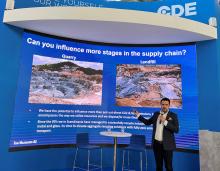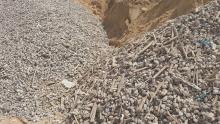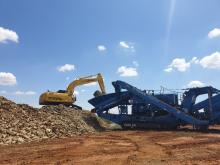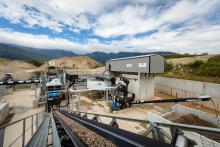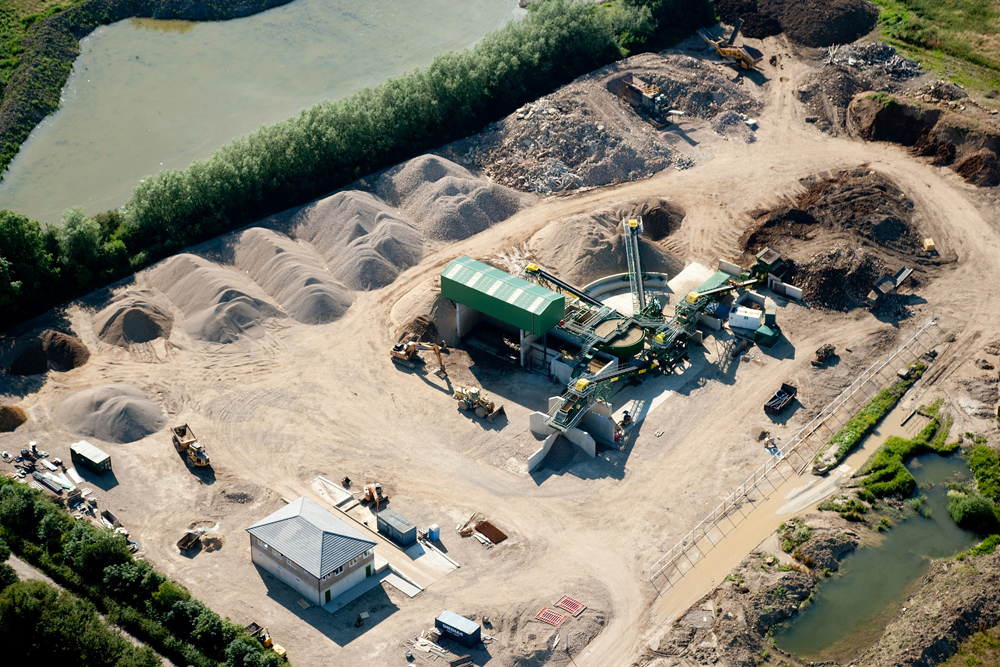
It is estimated by European Union data body, Eurostat, that construction and demolition (C&D) waste accounted for 36% of the total waste produced in the EU-27 countries in 2018, while quarrying and mining was responsible for a further 26.3%.
According to figures from the Department for Environment, Food & Rural Affairs, the UK generated 221 million tonnes of total waste in 2016, with CD&E (construction, demolition and excavation) activities accounting for an eye-opening 62% of that total, compared with 12% from household waste.
These large CD&E waste resources can be recovered to a high specification and returned to the construction sector to further the circular economy, according to Eunan Kelly, head of construction and demolition waste recycling at Northern Ireland-based wet processing plant manufacturer CDE.
Kelly stresses the importance of the right technology, and the right processes to unlock the concrete potential in recycled materials such as sand & aggregates.
He adds that, when supported with the appropriate processing practices and technology, sand and stone resources recovered from CD&E activities are suitable for high-value construction and infrastructure projects.

“In the materials processing industry, we’re having to speak out in defence of recycled sand and aggregates and lobby for attitudinal change to encourage greater acceptance and adoption of recycled materials,” says Kelly.
“We’re often told it’s not possible to produce structurally sound concrete from recycled sand and aggregates or it’s unfeasible to replicate the water-to-cement ratio with recycled products to produce a durable concrete.”
He adds: “These are arguments our industry is faced with regularly, and misconceptions that we at CDE move to challenge.”
Research is currently on-going to identify alternatives to sand and aggregates in concrete production. Some of the research centres around the use of woods, shredded-up vehicle components, and other unnatural concrete constituents. Kelly asserts that such research seemingly disregards the largest waste stream – from CD&E - and fails to recognise the fact that much of the material in this stream originates from the natural constituents of concrete, therefore lending itself perfectly to producing concrete.
“To combat depleting natural sand and aggregate resources we should better utilise the abundant incoming CD&E waste stream,” says Kelly.
Kelly says that, when it is being appraised, concrete produced from recycled sand and aggregates is unfairly pitted against higher-strength concrete produced using virgin aggregate, such as granite or basalt, and natural sand. He adds that not all granite or sandstone deposits display the same strength characteristics and therefore selective end-use logic is applied.
The same is true for sand and aggregates recovered from CD&E waste. Given the variability of rock geologies and other man-made aggregates, such as brick and bound concrete, Kelly says the same end-use logic must be applied.
He adds this should not undermine the potential of concrete produced from recycled materials. It is a case of identifying the strength of concrete that can be produced from recycled sand and aggregates and then pinpointing suitable applications for the product. “Current wet processing technologies deployed by CDE around the world can produce washed sand and aggregates that when used in the production of similar strength concrete are comparable in cement consumption,” says Kelly.
“Low-strength granite or gritstone would not be used to construct a multi-storey building, but we can identify suitable concrete-strength applications for their use. Similarly, with CD&E material, we may never use it to construct that same multi-storey building, but there are still many applications for which it is suitable.”
Thompson Recycling, based in Scotland, is an example of a company using C&D waste to produce a wide range of products for the construction sector. With the support of CDE technology, the firm is able to replicate the grading of local virgin sand deposits to provide the local construction market with a viable and creditable alternative to natural resources.
Current concrete-strength specifications allow for recycled aggregates to be used in the appropriate proportions to produce the required strength. Kelly says the majority of concrete produced is C40 strength or below. Approximately 75% of all concrete used globally is non-structural which he says begs the question, why are structural-grade aggregates being used to produce non-structural concrete?
“Surely we would use the appropriate material provided it gives us the appropriate outcome,” he adds. “In so many cases, globally, CDE customers are producing competitive concrete for these non-structural – but still high-value – construction projects, with some applications successfully achieving beyond C45.”
Soaring urbanisation presents a global challenge to meet the demands of the construction industry, and Kelly says that recycled materials are an effective solution when supported by the most appropriate technologies and practices.
It is anticipated that, by 2050, over two-thirds of the world’s population (68%) will be living in urban settings, according to data from the United Nations, rising from around 55% of the population today.
Currently, an estimated 40-50 billion metric tonnes of primary aggregates – crushed rock, sand, and gravel – is extracted every year, and GAIN, the Global Aggregates Information Network, in its global outlook to 2030, estimates aggregates production will rise to 60 billion tonnes per year over the next decade to support growth in urban populations.
CDE customer Velde Pukk AS plays a significant role in meeting the material demands in Stavanger, Norway, in the face of a construction boom. Utilising high-quality recycled aggregates and its on-site concrete batching plant, Velde Pukk AS supplies the construction industry with a CE-certified concrete from 100% recycled sand and aggregates.
“The recycling sector will continue to grow and it will gradually become more competitive,” says Kelly. “CDE is working with its customers to stay ahead of that curve and to adopt efficient and sustainable technologies that are future-ready. Those customers who have integrated wet processing technology into their plant are reaping the commercial advantages of superior end products and are facilitating sustainable construction by recovering high-quality recycled materials.”
Robust debate is needed in the South African construction industry to map a way forward for the recycling of demolition material on the country’s construction sites, according to national surface mining industry association ASPASA.
The association says that little research or planning has been released to plot a way forward with recycling, and complexities exist that will need to be resolved before industry-wide use of the practice becomes viable.
ASPASA director Nico Pienaar says it will need close cooperation between all parties concerned to be successful. This includes the civil engineering fraternity that will be required to compile standards for recycled aggregates, quarries which have the equipment required to crush and screen material, as well as the demolition industry and recycling experts who will need to apply certain processes to prevent contamination of the material.
“Recycling of building material for any other purpose than backfill is a complex business,” says Pienaar. “It requires complete separation of materials such as clay bricks, steel, glass, wood and other construction materials in order to guarantee the strength and durability of structures built with recycled constituents.”
Pienaar says that perhaps more significant is the correct grading of recycled materials that will change depending on the type of load and the construction site. It may even be necessary to have a new breed of specifiers who are qualified in the assessment of structures to be demolished, and paths for the recycling and grading of material.

He adds that successful projects are already in operation in other parts of the world where incentives exist and legislation requires the use of a certain percentage of recycled materials.
However, without similar market requirements and incentives, the recycling of building rubble may prove to be too costly or specialised for the local market to grasp. South Africa has an abundance of suitable sands and aggregates and Pienaar says that price-driven market forces are likely to render recycled materials uncompetitive.
Even if a successful industry is launched, Pienaar states that the market in even the most advanced recycling countries is only about a 20% substitution and the construction industry will still need to be supported by a strong, healthy and profitable quarrying industry.
“New legislation around the use of recycled materials will need to be devised, as will permitting, and standards need to be introduced to ensure quality construction in future,” says Pienaar.
Pienaar is therefore encouraging other government, professional bodies, companies and individuals to make contact with ASPASA to begin setting up the process of establishing a forum to drive the way forward. “With space running out in the country’s landfills, the time to act is now,” he adds.
Ease of transport and high performance swung the purchase of a Rockster R900 impactor by Martin Meier Erdbau in Germany’s Upper Palatinate area.
Demolition business, earthworks and transport have been Meier’s specialties since the company’s founding in 1977. With 16 employees and a fleet of around 50 construction machines and trucks, the Bavarian company is extremely well positioned. Up until the purchase of the Rockster R900, recycling construction waste from bridges and buildings had been outsourced.
But the number of demolition projects has been increasing steadily over the years, and the disposal of construction waste has become more and more expensive. Martin Meier Erdbau bought the R900 mobile crusher so demolition material could be recycled anywhere and anytime.
Transport is also easy with the unit’s dimensions of 9.6m in length, 2.5m in width and 3.2m in height, and a weight of only 25.5 tonnes.

